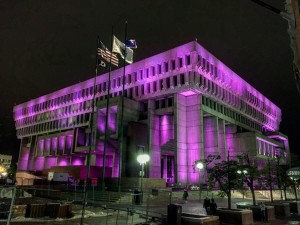Long known for its brownstones and buttoned-down image, Boston is embracing the new generation of lighting technology designed to show off its latest developments and historic landmarks alike.
LED floodlighting has become a popular strategy for office and multifamily developers to draw attention to just-completed properties that could get lost in the shuffle of a busy ribbon-cutting season. A 400-foot-long LED strip runs down the side of Avalon North Station, the city’s tallest apartment building, which opened last week.
“We call it the ‘lightsaber,’” said Alfred Wojciechowski, a principal at CBT Architects in Boston, referring to the largest of three LED installations on the 38-story tower. “It’s meant to be extremely dramatic in the black silhouetting of the building.”
Recent advances in lighting technology – including components manufactured by a one-time North End startup, Burlington-based Philips Color Kinetics – enable landlords to bathe buildings in hues that can change color at the touch of an iPad. Think about gold accents if the Bruins have a big game, or pink lighting to raise breast cancer awareness.
The transformation has been largely free of controversy, a reflection of changing attitudes in a city where the iconic John Hancock Tower was initially denounced as an outrage, but where preservationists now are rallying to bestow protected landmark status upon a certain oil company sign in Kenmore Square.
“We’ve had discussions with the city about not getting too carried away,” said Greg Galer, executive director of the Boston Preservation Alliance. “We don’t want it to look like a carnival. But in general you’re seeing a trend toward projects that in historic and new buildings try to highlight the architectural features.”
Exterior lighting is part of the Boston Planning and Development Agency’s Article 80 process for large developments, while the Boston Civic Design Commission also has a say.
“Some developers like to showcase their buildings, some less so,” said David Carlson, deputy director of urban design at the BPDA. “We work with them if they have an opportunity to do something that fits in with the skyline and doesn’t overwhelm or dominate it.”
Visions Of A ‘Diamond Necklace’
The nonprofit group Light Boston first envisioned in the late 1990s a “Diamond Necklace” and drew up lighting standards for 25 local landmarks and historic structures in the city. Using matching grants from Historic Boston, the group worked with designers on illumination of several church steeples and historic buildings such as the old John Hancock Building at 175 Berkeley St.

Boston-based CBT Architects designed three LED light installations at Avalon North Station including a 400-foot-long strip that runs down the side of Boston’s tallest apartment building.
While those projects used high-pressure sodium or metal halide components, advances in LED lighting in the past decade have cut the cost of installation and operation. Metal halide lightbulbs need to be changed every four years or so, one of the considerations that prompted Boston Mayor Martin Walsh to support replacing the original lights at the 1968 city hall.
“You’d wait for a couple of lights to go out and you’d spend $10,000 to rent a lift and get somebody up there, motor around and replace four or five lights at a time,” said Pat Brophy, the city’s chief of operations.
The $628,000 project completed in October replaced them with 438 LEDs manufactured by Montreal-based Lumenpulse, which can beam up to six colors simultaneously on the Brutalist edifice. Currently, a red-and-green combination is being used to highlight the Boston Winter ice rink and holiday kiosks on city hall plaza.
“When we turned on the lights for the first time, somebody who works here said, ‘Geez, I actually get to work in a cool building,” Brophy said. “For someone who’s been here 22 years, I don’t think I’ve ever heard anyone say that about City Hall.”
Coolness quotient aside, the new equipment is expected to reduce the property’s electric bill by 300,000 kilowatt hours annually. And the LEDs only need to be replaced once every 20 years.
Limitless Potential For Placemaking
Burlington-based Philips Color Kinetics, founded in 1997, is behind the LED lighting installations on the Leonard P. Zakim Bunker Hill Bridge and the Custom House Tower, along with nationally-renowned projects such as the 25,000-bulb Bay Lights sculpture on the San Francisco-Oakland Bay Bridge. Philips acquired the company in 2007 for $791 million.
“A few engineers and entrepreneurs came together with an idea: that the little LED lights in your calculators could someday light up the skyline of Manhattan or Boston,” said Paul Kennedy, Philips Color Kinetics’ general manager. “But it’s only been the last 10 years that (LED) has been feasible from a performance and economic standpoint.”
The ability to program color schemes to raise charity awareness or commemorate holidays fosters civic pride and connect communities, he said. And LEDs are a low-cost way to developers and community organizations to revitalize rundown neighborhoods, saving up to 80 percent in energy costs compared with traditional lighting.
Four companies will pitch proposals in January to the BPDA for a $470,000 lighting array on the Congress Street bridge spanning Fort Point Channel. Allston-based Light Time in Space Inc., Hartranft Lighting Design of Andover, Parsons Brinckerhoff and Salem-based Available Light responded to a request for proposals this month.
“They’re looking for something that’s more than just lighting the bridge,” said Paula Ziegenbein, a senior consultant for Hartranft Lighting Design. “They want something that’s going to be mindful of this area and the waterfront district reactivation, but also something to create a sense of destination and placemaking.”
Replacing the 175-watt high-intensity lanterns on the bridge’s piers with LEDs will reduce power consumption by up to three-quarters, with the potential to add dynamic displays drawing fresh attention to neighborhood landmarks.
“It could be a show that’s set to music or coordinated with the Boston Tea Party museum,” Ziegenbein said. “It’s limitless, really.”




 |
| 




